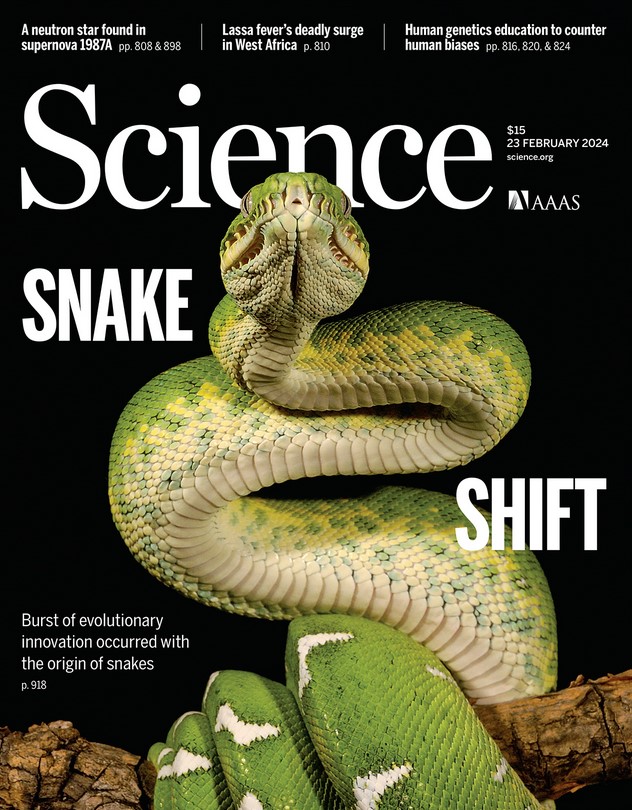
After almost a decade studying and researching the evolution of snakes, CSUDH Biology Professor Sonal Singhal has come to one undeniable conclusion.
“Snakes are so cool!”
Since 2014, Singhal has been one of the leaders of a project attempting to discover why snakes have been so successful in evolving traits that allow them to survive and thrive almost anywhere in the world. Their findings were published as the cover story of the February 24 issue of Science magazine.
“Snakes are actually lizards if you use a technical definition,” says Singhal. “But if you look at them from an evolutionary perspective and how aspects of their biology are changing —what they eat, what they look like, how they’re changing, how many species there are—we can see that snakes are doing something completely different from lizards. Snakes are evolutionary successful in a way that lizards just aren’t.”
Singhal started the project while she was a postdoctoral researcher at the University of Michigan. “The initial goal of the project was much more limited,” she says. “We were just trying to understand the timing of when different lizards and snakes in Australia spread across the continent. But one thing led to another, and before we knew it, we had a thousand samples and this huge dataset. We thought that maybe we should be asking a different question with this.”
For the study, the team generated the largest, most comprehensive evolutionary tree of snakes and lizards ever by sequencing partial genomes for nearly 1,000 species. In addition, they compiled a huge dataset on lizard and snake diets, examining records of stomach contents from tens of thousands of preserved museum specimens.
They fed this mountain of data into sophisticated mathematical and statistical models, backed by massive amounts of computer power, to analyze the history of snake and lizard evolution through geological time and to study how various traits, such as limblessness, evolved.

This multipronged approach revealed that while other reptiles have evolved many snakelike traits—25 different groups of lizards also lost their limbs, for instance—only snakes experienced this level of explosive diversification.
“We found that snakes have been evolving faster than lizards in some important ways, and this speed of evolution has let them take advantage of new opportunities that other lizards could not,” said University of Michigan evolutionary biologist Daniel Rabosky, who served as a co-lead on the project with Singhal and Pascal Title, assistant professor at New York’s Stony Brook University.
For Singhal, one of the study’s most important takeaways is the idea of a ‘macroevolutionary singularity.’ The term represents a once-in-evolutionary-history event with “unknown and perhaps unknowable” causes.
“That term can be a bit jargony, but what it means is that there are these one-off events in evolutionary history that no one could ever predict, but that fundamentally reshape how life looks around us,” she explains.
“Bats are a really cool example of this,” Singhal says. “Because bats are mammals. Where did bats come from relative to mammals? There’s nothing about the early history of mammals that would have predicted the evolution and rise of bats. But there are these one-off evolutionary events – like the evolution of bats – that as biologists who study the tree of life, we’ve had an intuition about. What was cool about this paper is we had enough statistics and data to actually test for that.”
A macroevolutionary singularity can be seen as a sudden shift into a higher evolutionary gear, and biologists suspect these outbursts have happened repeatedly throughout the history of life on Earth. In the case of snakes, the singularity started with the nearly simultaneous (from an evolutionary perspective) acquisition of elongated legless bodies, advanced chemical detection systems and flexible skulls.
Those crucial changes allowed snakes, as a group, to pursue a much broader array of prey types, while also enabling individual species to evolve extreme dietary specialization.
In all, the team analyzed field observations and stomach-content records for more than 60,000 snake and lizard specimens, mostly from natural history museums. Although she didn’t know much about snakes when she started the project, Singhal now counts herself as a big fan of the slithery creatures.
“My favorites are blind snakes,” she says. “They have reduced eyes, can’t see very well, and tend to spend most of their time underground. I really developed a fondness for those snakes through this project.”
Singhal is also proud to contribute to snake research. “It has historically been an extremely male dominated field, maybe because snakes are seen as dangerous. The stereotype is these macho males who go out and battle the snakes. So I was very proud, as a female, to be helping lead this project and to show people that there are a number of very prominent female snake biologists now.”
The study’s 20 authors are from universities and museums in the United States, the United Kingdom, Australia, Brazil and Finland. The study was supported by several funding agencies, including multiple grants from the U.S. National Science Foundation.








